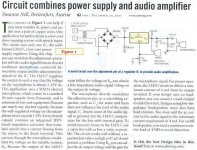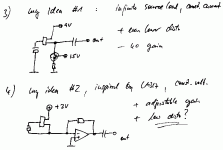Attachments
But you'd have to be a bit of a sausage to use a voltage reg as an amp...
Stop posting silly circuits, mrfeedback. 😉
Stop posting silly circuits, mrfeedback. 😉
Look at http://www.linkwitzlab.com/images/graphics/microph1.gif for the two standard ways to hook up an electret.
1) suggested by Panasonic uses the FET in common source mode, with a gain resistor in the drain connection:
+ gain
- distortion of the FET in common source mode
2) suggested by Sennheiser and Siegfried Linkwitz, uses the FET as a source follower with a 10 k load impedance:
+ lower distortion
- no gain
3) I have been thinking about replacing the 10 k with a constant current source:
+ even lower distortion
- higher parts count
- still no gain
The LM317-circuit gave me another idea:
4) Use the FET as it is, i.e. without disconnecting the membrane from the source. Connect the drain to a stable 2 V supply. Connect source to a virtual ground (negative input of op amp). The gain can be set through the feedback resistor. This hookup keeps the voltage across the FET constant and measures the current, just like the LM317. Haven't had time to look at typical FET curves. Would this by chance be more linear than 2) or 3)?
1) suggested by Panasonic uses the FET in common source mode, with a gain resistor in the drain connection:
+ gain
- distortion of the FET in common source mode
2) suggested by Sennheiser and Siegfried Linkwitz, uses the FET as a source follower with a 10 k load impedance:
+ lower distortion
- no gain
3) I have been thinking about replacing the 10 k with a constant current source:
+ even lower distortion
- higher parts count
- still no gain
The LM317-circuit gave me another idea:
4) Use the FET as it is, i.e. without disconnecting the membrane from the source. Connect the drain to a stable 2 V supply. Connect source to a virtual ground (negative input of op amp). The gain can be set through the feedback resistor. This hookup keeps the voltage across the FET constant and measures the current, just like the LM317. Haven't had time to look at typical FET curves. Would this by chance be more linear than 2) or 3)?
Me and a buddy are working on an electret mic project for recording drums. We plan on hooking up one little capsule per drum/cymbol, and mixing it all down to two channels. We had to modify the electrets a la linkwitz because the loud sounds were saturating the FET stage inside the capsule.
Although we're still putting it all together, the one mic that I did make was decent. They are supposed to have pretty flat response, so I'm wondering why studios etc don't use them regularily. At like $0.50 a pop, you can't go wrong.
Pete
Although we're still putting it all together, the one mic that I did make was decent. They are supposed to have pretty flat response, so I'm wondering why studios etc don't use them regularily. At like $0.50 a pop, you can't go wrong.
Pete
LOL. 😀Circlotron said:But you'd have to be a bit of a sausage to use a voltage reg as an amp...
Stop posting silly circuits, mrfeedback. 😉
X-Version Coming Soon....
LOL. 😀Circlotron said:But you'd have to be a bit of a sausage to use a voltage reg as an amp...
Stop posting silly circuits, mrfeedback. 😉
I'd be interested to see how this measured in this application. The 317 isn't particularly quiet IME, noisy enough in fact that used as the CCS in my shuntregs in the phonostage B+, there was a noticable difference in noise level when I tried a discrete one based around IRF fets.
- Status
- Not open for further replies.
- Home
- Amplifiers
- Solid State
- LM317 As Electret Mic Amplifier


